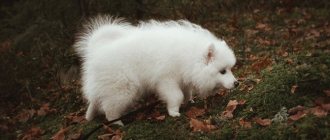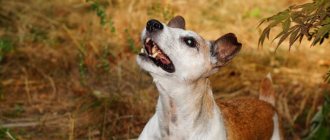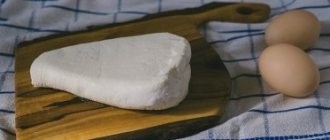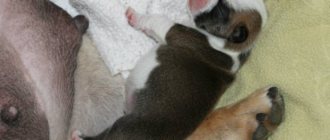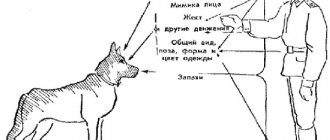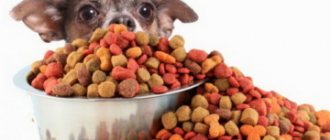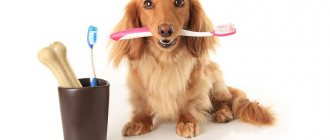Dog English Bulldog
The English Bulldog is a short-haired mastiff-type dog breed.
Initially, the bulldog breed served for an extremely negative task - baiting animals, bears or bulls. In addition, the English Bulldog dog was the main participant in dog fights. The purpose of the breed lasted 6 centuries. In those days, the main criteria for choosing dogs remained courage and ferocity, and considerable attention was paid to endurance. Fortunately, the breed was destined to survive and delight dog breeders. Some countries still organize dog fights to this day, where bulldogs continue to take part. The year 1835 was marked by a ban on dog fighting, which had an extremely negative impact on the life of bulldogs, who found themselves on the verge of complete extinction. However, thanks to the merits of Bill George, who continued breeding, the English Bulldog breed was preserved, becoming an irreplaceable and valuable friend to man.
Gradually, interest in dogs increased, which led to the establishment of the first bulldog club in England in 1974. Russia became acquainted with wonderful dogs before the revolution, but the widespread development of the breed in Russia occurred in the 80s of the 20th century and continues to this day.
A good nursery, how to choose one
A specialized kennel is the best place to buy a good English bulldog puppy. If pedigree and thoroughbred are important, then it is better to hire an experienced dog breeder to help. If not, then you can trust your heart. On nursery websites, there are customer reviews that will help you navigate. A little secret or life hack: visit a dog show where the desired breed will be presented. Chat with the owners of the breed, ask about the nuances, find out where they purchased the puppies. True dog breeders live for their pets, so they will be happy to answer any question and give valuable advice. Typically, nurseries send their representatives to exhibitions, where there is a chance to meet in person and take a business card.
Brief history of the English Bulldog
The breed acquired its name in the 13th century. In addition to the already described bull baiting, bulldogs actively participated in baiting rats, bears and even lions, which indicates the harsh nature of the ancestors of the modern English bulldog. The strength of the dog is evidenced by records from ancient times that mentioned the desired behavior of a bull dog. According to the standard of that time, the dog was designed to cling to the bull's muzzle and not unclench its jaws until the bull fell to the ground from exhaustion and let out a loud moo. The bull was considered defeated, and the owner of the winning dog received a large monetary reward.
In 1799, the first mention of the use of bulldogs in hunting large animals appeared. Later, there is evidence that the dog became an entrance into the houses of English secular society as a personal guard. The described beast of the English bulldog has survived to this day.
The secret of the origin of the massive dog lies in the name of the breed. The literal translation from English is “bulldog” – bull dog. The dog was originally bred for a specific popular pastime of medieval England: bull baiting. Other breeds, large and small, are no longer suitable for cruel entertainment. Large ones more often died from the horns of angry bulls, small ones - from the hooves. The main requirements for the new breed were powerful wide jaws, a strong grip, and targeting the bull's face. Bulldogs aimed at the legs, neck or ears were immediately rejected as unsuitable for baiting. By clinging to a part of the body other than the muzzle, the dog was at increased risk of being caught by sharp horns.
In the times described, English bulldogs were angrier, faster and more resilient than their relatives today. After the ban on bull baiting in 1835, it lost popularity, although for some time it was actively used in dog fighting. When the British aristocracy took notice of the breed and began using the dog for personal protection, the need for ferocity disappeared. Breeders began editing the breed to meet the requirements of the best English houses. The result is an entertaining creature. The current bulldog is a calm, mostly non-aggressive dog, slow in reactions and movements, in a constant thought process, snoring loudly in his sleep and having a dozen genetically determined diseases.
Nowadays, the English Bulldog is an excellent guard and companion dog.
Features of the first days of life
It is clear that giving birth to a purebred bitch should be entrusted to a qualified veterinarian. At the same time, you may have to take on the duties of a midwife while the doctor is on the road.
And when he gets to the woman in labor, he will almost certainly need an assistant. Be prepared when the puppy is removed or naturally emerges from the birth canal:
- Tear and remove the shell, starting from the head (nose) of the puppy.
- Remove mucus from the puppy's mouth and nose using a sanitary napkin.
It is possible that amniotic fluid will flow from the nasopharynx. This is normal and you can also take it on a tissue or tampon.
The specific “bulldog” structure of the nasopharynx sometimes makes these simple operations difficult, so be prepared to suck out the liquid with a special pipette.
A syringe is usually not suitable due to its too large size. If you are confident that you can hold a slippery newborn in your hands, you can shake out all the liquid in an up and down motion.
Scissors and thread should be disinfected ahead of time, for example, by soaking them in boiling water for 5-15 minutes.
Act energetically and remember the fragility of the newborn. This active massage promotes rapid drying and affects a number of functions:
- improves blood circulation;
- activates breathing;
- stimulates intestinal motility;
- promote the passage of meconium.
Baby care
English bulldogs, like newborn French bulldog puppies or other similar dogs, cannot maintain their body temperature on their own. In most breeds, heat loss is compensated by the mother, who warms the brood with her body.
Thanks to this, the puppy’s temperature range is normal - 35.5-37.8 ° C. In the English Bulldog, maternal care is rare, and the mother rarely gathers the puppies closer to her body, so newborns who cannot crawl will freeze.
Temperature conditions
To ensure thermal comfort, the box with puppies should be placed away from possible drafts and heating devices. This will avoid hypothermia or overheating and facilitate thermoregulation.
The temperature in the room with the brood should be within +24. +26 °C, and in the first week after birth, provide warming up to +29 °C. Air humidity should be between 50-70%. As bulldogs grow, the temperature should be lowered 2-3 degrees per week. After three weeks, a room temperature of +20 °C will be enough.
Cleanliness and hygiene
Ventilation of a room with a litter of bulldogs must be carried out daily (once) and is mandatory. The bed should be cleaned every day or when dirty.
It is recommended to bathe the puppy completely monthly or when it gets dirty (for example, after an active run through the mud). Use a special shampoo after consulting a dog trainer or veterinarian.
Washing paws is necessary after every walk in the fresh air and is usually carried out without the use of foam detergents. You can wash the face and folds on it every day and also without soap or other similar products.
If the puppy has not yet become accustomed to water procedures, then try not to frighten him, so do not raise your voice throughout the entire bathing or washing process.
Fill the bath with a little water - just above the little bather's knees. Comfortable temperature is the same as for children, and is determined simply - immerse your elbow in the bath to a depth of 6-9 cm.
If you don’t trust your feelings, then the thermometer should show + 36. +38 °C. Use a special shampoo and, if desired, a soft brush or fluffy washcloth.
Take care of children's pedicure in a timely manner so that the claws do not injure the bitch, and claw trimming should begin from the 4th-6th day of life.
We take care of our health
In the first weeks of a bulldog's life, you may need to regularly measure your body temperature, and here keep in mind that the normal temperature is 35.5-37.8 °C, and 34.4 °C is definitely hypothermia.
In such cases, place a heating pad in the box, but best of all, place the puppy close to your body - chest or stomach. In normal health, newborn English Bulldogs develop so that at 10 days the weight will be twice as much, and at 15 days of age - three times as much as at birth.
Healthy cubs actively gain weight weekly, and during the first month they can gain about 3 kg. At one and a half months of age, the weight can be 3.2-3.5 kg, at two months - at least 5 kg, at three months - about 10 kg.
By the first half of the year, normal weight will be 15-17 kilograms. Meanwhile, like our children, dogs develop individually, so periodically consult a specialist regarding weight standards and general development.
For natural reasons, newborn puppies cannot empty their bowels or bladder on their own. The mother helps them in fulfilling their physiological needs by stimulating the tummy and anus with her tongue.
When dealing with Bulldogs, be prepared to stimulate both with your fingers - lightly stroking along the peritoneum and using circular movements. To stimulate the anus, use a neutral lubricant - mineral or silicone.
Vaccination of puppies begins at the age of 8-9 weeks with vaccination against adenovirus infection, infectious hepatitis, leptospirosis, parainfluenza, enteritis and canine distemper.
Then, at 12 weeks of age, revaccination against the listed diseases and rabies vaccination are required. At one year of age or after changing teeth, all of the above procedures should be repeated. As the bulldog gets older, annual revaccination is carried out.
Attention and love
Many years of practice show that keeping and caring for a newborn English Bulldog is more of a concern for the owners than for the mother. Exceptions are rare, so you shouldn’t rely on a bitch.
She carried her offspring, gave birth, provides them with adequate maternal nutrition - and thank you for that.
As puppies develop, teeth erupt, and the feeding process is accompanied by painful biting of the nipples. A nursing mother strives to leave her brood before the babies satisfy their hunger, and coercion is necessary here.
Psychological comfort is unrealistic without physical comfort, so, first of all, provide puppies with:
- timely food;
- acceptable temperature and humidity conditions;
- hygiene;
- silence in the room.
Regular walks around the room begin when the puppies begin to stand on their own. Walks outside the house should begin at one and a half months of age (when all necessary vaccinations have been completed) and should be done daily.
And it’s very good when by this time the puppy has mastered simple commands and remembered his name. When choosing a nickname, focus on words with two syllables. Simplicity will help your pet remember its name quickly.
Refrain from nicknames that are similar to the names of your household members, including cats, birds and other pets (to avoid confusion in the dog’s head). Exotic names would be appropriate: Archie (Archibald), Batman, Betsy, William, Christie (Christina), Richard, Roger...
Care and maintenance
The peculiarity of English bulldogs is their freedom-loving disposition, so they cannot be kept in an enclosure or on a chain; they must be close to the owner. In a house or apartment, your pet must be given a separate place to rest away from drafts and radiators, but you should not be allowed to sleep on the owner’s bed.
It is advisable to make the “dog corner” elevated, since this breed, with its lazy character, prefers to move more. Bulldogs are quite clumsy creatures, so you need to choose a deep bowl for food so that the dog does not overturn it, they also love to chew something, so it is advisable to buy them a special toy or a rubber bone.
Since this breed is prone to obesity, it is necessary to take walks with it; you need to walk with an English bulldog twice a day, preferably in the morning and in the evening, but the walking time should be short, 30 minutes is enough.
The dog's coat must be brushed with a stiff brush once every seven days, and every day when shedding. You can’t bathe an English Bulldog often, as there is a high risk of decreased immunity, the recommended rate is one bath every 4-6 months.
If the dog gets dirty, you need to wipe the fur with a damp cloth. Also, special attention must be paid to skin folds, especially on the neck; they must be wiped with a special lotion once every three or four days. It is also necessary to inspect and clean the pet’s ears, nails, and teeth.
What to feed an English Bulldog puppy
Newborn puppies should eat every 3 hours (day and night) for the first two weeks. It happens that puppies are too lazy to suckle on their own, and so that they do not starve, they will have to be fed artificially.
You can use dry bitch milk (sold in pet stores), after diluting it with water at room temperature. Feeding with a tube is allowed, but this requires special skills that are best mastered with the help of a veterinarian.
It's easier to master a baby bottle with a nipple. Before feeding your English Bulldog puppy from the pacifier, check the size of the pacifier opening. Too much will lead to excessive laziness, which will negatively affect the entire future education of the bulldog.
During the care process, it is necessary to monitor the development of the cubs, regularly weighing their weight. You can obtain a table of normal body growth from a specialist. To stimulate lactation, the bitch should be fed tea with milk, cottage cheese and fermented milk products.
Natural nutrition
Feeding puppies is recommended from two weeks of age. You can give fresh raw beef (and only) finely scraped.
Daily meat intake:
- in the first week of complementary feeding - 10 g;
- in the second - from 15 to 25 g;
- in the third - from 40 to 50 g;
- in the fourth - 100 g.
The entire daily intake should be divided into 3-5 equal portions.
Along with meat, you can introduce cottage cheese (diluted with milk or yogurt) and kefir into your diet. From the third week of feeding, you can combine meat with dairy products and cereals (rice and buckwheat are recommended). White bread with milk won't hurt either.
If regular kefir and cottage cheese cause indigestion, then you should either switch to varieties intended for baby food or additionally process fermented milk. For example, make a casserole from cottage cheese (in a regular or microwave oven), and boil kefir until it becomes a curd mass, which should be fed.
Dry food
You should switch to dry food from the age of one month, and coordinate your choice with a specialist. In any case, pre-soak dry balls, “seeds”, “pads” and other “grains” (in kefir or water) until they become a soft, homogeneous paste.
Serve in small doses (half the serving indicated on the package) once daily at first. In the second or third week, the regularity can be increased to twice a day. During the transition to a new food, monitor the bulldog’s reaction; the duration of the transition period depends on this.
Keeping at home
ENGLISH BULLDOG will not give you much trouble in caring for them. It is necessary once a week, using a special brush or rubber glove, to clean the fur of any dead hair that has formed. It is worth considering that shedding in such dogs continues throughout the year, but in the spring and autumn it intensifies. Therefore, during these months, dry shampoo can be used to thoroughly clean the coat. Since the skin of Bulldogs mainly contains fat cells, and there are no sweat cells, it is worth bathing the dog once a month, or even better, once every two months. Pay special attention to the folds and the area under the tail. Dirt often accumulates in such places, which can cause inflammation and lead to various infections. In winter, every time after a walk, inspect and wash the paw pads. Since the salt that is sprinkled on the street can negatively affect their condition. Namely, the pads begin to crack and become inflamed, and the claws weaken and begin to peel off. Therefore, before a walk, it is better to lubricate them with Vaseline or sunflower oil. It also monitors the growth of the claws; if necessary, they should be trimmed in order to avoid looseness of the paws.
Exercises for the English Bulldog:
Until two years old, English Bulldogs are quite active dogs. But having crossed this annual milestone, they almost stop playing and frolicking. They say that at this age, they become real gentlemen, with their inner dignity, they cannot afford pranks. Therefore, such dogs are not sporting breeds; they will not keep you company while hiking, jogging, or especially jumping over barriers. For them, the best option is leisurely walks with their owner.
English Bulldog training:
Teaching English Bulldogs good manners is not particularly difficult. After all, correct adaptation to humans is genetically embedded in them. You will be surprised when you bring a puppy into the house and you will see that it only took them a couple of hours to quickly get their bearings in the new environment. They will already know where their toilet is, where their bowls are, what toys they can play with and which they shouldn’t. But despite the advantages of their genetic makeup, English Bulldogs need to be educated. It is immediately worth noting that such dogs should absolutely not be kept on a chain or in a closed enclosure. They must live in a house with their family. From the first days, let your pet understand who is boss in the house. Don't accept harsh parenting methods, they are very understanding if you explain to him in clear and kind words. The only method you can use is the following: press him to the floor by the withers and hold in this position for several minutes. So you show your pupil that the leader in this house is you. Let us emphasize once again that raising such a breed is not at all difficult. The first three months are the most important in training. But most importantly, by showing sincere love for your pet, in return you get a devoted, obedient and reliable friend.
Mating bulldogs - a necessity or a luxury?
Mating bulldogs is an important point that should be considered by the owner from all sides. If you are the owner of a male bulldog, and in your imagination the pet is depicted as the father of the family, we advise you to cool down a little and look at what pedigree your dog has. It is also worth paying attention to the exterior of the dog: if there are defects or some asymmetries in the dog’s appearance that are not characteristic of the breed, then thoughts about a stud dog should be abandoned once and for all, since breeding puppies involves cultivating better puppies than their parents. Another argument for breeding a male dog will be the presence of high certificates and your joint achievements at exhibitions.
It is important that the pedigree of the dog does not contradict the data of the bitch with whom you are going to mate your dog. If the closest relatives of the male offspring had a marriage, or some kind of mental abnormality, then hopes for breeding puppies or just mating should be abandoned, since heredity is an irreconcilable thing that can ruin both the bitch who conceives babies and the puppies that are born from an unsuccessful mating. There is no guarantee that the intricacies of DNA and patterns of heredity will not work out in this particular litter of puppies. The mental state of a male dog, contrary to popular myth, does not depend in any way on whether he had mating or not. The whim of the owners to have their dog with a bitch at least once can lead to the fact that the English bulldog will look for a female in heat, and once again, in an attack of spring exacerbation, he may simply tag along with the mongrel and not return. If you untie your male bulldog, then you don’t need to be surprised when your walks together turn into punishment - the angry bulldog will smell the smell of heat everywhere. You can’t have a normal walk with such a preoccupied individual. Experienced dog breeders say: not all male bulldogs can get the right to mate.
Only high-quality and well-groomed representatives enjoy this right. The owner’s love and care will ensure that the dog is in a good mood and has no mental deformations, which is the key to the dog’s good development. You also need to remember that if you really want to marry your male bulldog with a female, then be prepared for the fact that the owners of purebred females may refuse you, since an unplanned mating can disrupt all the rhythms and cycles of the animal that were set by the owners. They may have in mind the best male dog with breeding aspirations. If you have a female dog at your disposal, then the solution to the problem is more complex than with males. Such a phenomenon as false pregnancy can disappear only if, after estrus, the female becomes pregnant and a colossal hormonal change occurs in the dog’s body. After estrus, an unmated bitch may again resume false whelping, and so on until the dog cannot bear and gives birth to puppies. False pregnancy manifests itself differently in different bitches; heredity and the dog’s upbringing play a big role in this.
In order to mate a bitch with a purebred dog, you must answer the question of why you and, first of all, your dog need this. Fussing with puppies and caring for them will give you a lot of pleasure, but do not forget that breeding puppies is a labor-intensive process that involves spending significant funds on complementary feeding, equipping a playground for puppies, and on veterinary care (a female bulldog often gives birth to using a caesarean section), as well as for advice from a dog handler, etc. There is no need to breed puppies if there is no desire and sufficient material resources that would ensure normal development and well-groomed appearance, which are the main parameters when choosing and purchasing a bulldog puppy. Mating may become mandatory if your female bulldog has interesting blood, good pedigree, awards, an easy-going character, as well as significant ancestors with awards and certificates. Also, sometimes a bulldog bitch makes some people want to see and buy puppies from her. Entire matchmaking sessions are practiced with promising bulldog bitches.
Unfortunately, the lack of funds and basic care leads to careless breeders adding to the collection of ordinary, mediocre dogs. Sometimes this is aggravated by the fact that the puppies are poorly fed, and their development goes in a different direction. The result: dull fur, bad temperament, thin build, grinding of the breed and, in the end, free distribution of unattractive offspring among friends. Experts urge you to be reasonable and soberly assess the situation when mating bulldogs. You have unique hereditary material in your hands; it is important not to spoil it and not to let the development of the tribe go in the wrong direction. Often breeders push their personal females or males forward, taking away the right to mating from more promising individuals. In this case, you need to be a vigilant owner and not allow your animal to be used to increase the prestige of some bulldog breeder. The breeding candidate must be tested and matched to your dog's pedigree. Primitive representatives are the scourge of the breeder; such dogs should be excluded from production coldly and impartially. It is unacceptable to breed mentally unstable dogs that will poison the lives of their owners. A personal attitude towards a dog as one’s own child will help make it a deep, balanced, self-sufficient individual who will bring joy and satisfaction to its owners.
NUTRITION
The peculiarity of the English Bulldog's diet is primarily related to physiology. A bulldog is a strong dog with impressive muscle mass; therefore, in order to maintain this mass at the proper level, protein is needed, which leads to feature No. 1: the English Bulldog’s diet should be shifted in favor of protein-rich foods. Bulldogs have “complex” digestion, therefore, feature No. 2: the diet is easily digestible and low-fat. Representatives of this breed are predisposed to urolithiasis, which is why: feeding them only meat is prohibited! Also, it is worth taking into account the physiological features of the structure of the masticatory apparatus (jaws), in view of which, bulldogs experience difficulties with fully chewing food (if a bulldog thinks that “you can swallow without chewing,” then why chew and chew? He will swallow! and exaggerate his “ opportunities” they can, they can).
Oddly enough, most breeders do not recommend feeding bulldogs dry food (“chemicals and all that”). I am all for “dry feeding”! But, if the choice fell on “dry” food, then not cheap, but only premium class: balanced and easily digestible, and the best option is specialized food specifically for dogs with “problematic” digestion (well, “complex” or “problematic” digestion because bulldogs do not chew, but swallow).
If you give preference to natural food, then this certainly does not mean “feeding the bulldog from the table”, I will say categorically - IT IS IMPOSSIBLE! Here, balance and variety are very important (plus, you will need to make an effort and independently calculate the calorie content and protein content, unlike ready-made food, where “everything is down to the milligram”). But don’t worry, not everything is as complicated as it might seem at first glance. In a few months or years, you will have your own “collection of recipes for your favorite dishes” for your beloved bulldog!
Like other dog breeds: sweet, salty, smoked (and also fatty for bulldogs) - absolutely not allowed! The basis of nutrition is porridge (buckwheat, rice, rolled oats), it is better to cook it in meat or bone broth (poultry, beef, rabbit). Do not give any bones to the bulldog! Vegetables and fruits must be included in the bulldog's daily diet (carrots, cucumbers, apples, all unsweetened fruits and berries are also welcome). Once/twice a week treat with fermented milk products (low-fat cottage cheese, fermented baked milk, kefir), improves digestion + available calcium. It is advisable to give meat and offal boiled and chopped, so it is better absorbed.
There is another type of nutrition - mixed (a combination of natural and dry feeding, or alternating them). This type is very common, but I’m not a fan, although it happens...
Diseases
English Bulldogs are predisposed to the following diseases:
- Cherry eye
- Entropion
- Distichiasis
- Keratoconjunctivitis
- Heatstroke
- Skin fold dermatitis
- Demodicosis
- Interdigital dermatitis
- Acne
- Hip dysplasia
- Congenital dislocation of the elbow
- Tracheal hypoplasia
- Hypothyroidism
- Brachycephalic syndrome
- Difficult birth
- Vaginal hyperplasia
- Cryptorchidism
- Ventricular septal defect
- Tetralogy of Fallot
- Aortic stenosis
- Lymphosarcoma
- Deafness
How much does a puppy cost?
It is best to purchase an English Bulldog puppy from breeders with a good reputation and positive reviews. How much a companion dog costs depends on the owner’s future plans.
If you need a faithful, loving friend, you can buy it relatively inexpensively, about 10-18 thousand rubles. For this price, the puppy will not have a pedigree or documents.
When the plans are larger - competitions, exhibitions, the puppy must meet the official breed standards. Then the price is much higher, from 30 to 60 thousand rubles.
We begin training and education
The process of education begins from the first days of life, for example, stimulating lazy puppies to be active while still feeding with a pacifier. The second step is getting used to eating from a bowl, and it begins when the cub is fully sighted.
Further, the education of an English bulldog should be increasingly focused on getting to know the outside world. At the same time, the owner must carefully guide the four-legged fool to avoid unnecessary mental and physical injuries.
Education needs to be done every day. The bulldog must follow the rules established in the house without any concessions, no matter what age he is.
It is necessary to strictly monitor, and when the puppy has not yet mastered the established order in the house and does not know what is not allowed, it is necessary:
- reward with words and stroking for correct behavior;
- give him a good shake by the collar and remark in a dissatisfied voice when the bulldog breaks the rules and does not respond to commands.
It is necessary to stop violations by pulling by the scruff of the neck while the bulldog is small. You should not abuse it - punish only for real violations; dogs sense injustice no worse than people.
When it becomes clear that the owner (mistress) is bigger and stronger, that is, more important, the dog will begin to obey without resistance. The sooner the dog realizes its place in the domestic hierarchy, the better for both the owners and it.
If the bulldog cannot master the command for a long time, it is necessary to interrupt training for two or more days. It is possible that he is not mature enough to understand this command; in this case, training should be resumed in no less than two weeks.
Each bulldog training method is based on the carrot and stick principle (reward and punishment).
Use as encouragement:
- kind words (praise) with a good-natured expression;
- tactile caress (stroking);
- additional entertainment (an extra walk without a leash, a toy);
- favorite treat, which varies from dog to dog (cracker, dry bread, cheese, bone).
It is better to punish the puppy remotely, without contact (use a shout, splashes of water, a threatening gesture).
If it doesn't help, shake it lightly by the collar. Puppies do not understand prolonged verbal reprimands and restriction of freedom. In conclusion, it remains to add that there are not so many nuances in raising a growing child and maintaining an adult dog. This dog is kind, easy-going and no more aggressive than other guard breeds.
All the specifics of keeping bulldogs are determined mainly by the peculiarities of their anatomy: incorrect (back) bite, disproportionately large head, folds of skin on the head and neck.
Documentation
- An English Bulldog puppy has a mark in the groin area or it may be on the ear, as well as a puppy card (metric). The codes on the card and on the stamp must be identical.
- Metrica is the primary document that is issued for a puppy when it reaches the age of 45 days. Next, a qualified dog handler examines the babies and notes any defects found. The owner of the dog, if desired, can change the metric to a new document, pedigree, at the age of 6-15 months. This document will allow the pet to participate in breeding.
- Another document for the puppy is a veterinary passport, with mandatory vaccination and deworming notes. When the documents have been checked and everything is in order, you need to ask the breeder in detail. Take his number, at first a lot of questions will arise, especially for new dog breeders.
Description and history of the breed
The English bulldog is a real national symbol of England, because this country is the birthplace of the breed. Few people know that initially such cute dogs were used for rather cruel purposes - for baiting bulls. And, by the way, the name comes precisely from this purpose: it literally translates as “bull dog.” By the way, the folds helped in fights and served as protection from damage. Dogs were also often taken to hunt wild boars, and they were reputed to be excellent hunters.
Pros and cons of the breed
Because of the affection of English bulldogs for their owners, it is better to take them with you on vacation.
Owners of English bulldogs note the following advantages of this breed:
- cheerful, good-natured disposition;
- sociable and gets along well with children, and if the family has cats or other dogs, then the bulldog is peaceful with them;
- senses the owner’s mood well;
- smart and balanced;
- indispensable as a companion on long journeys.
At the same time, everyone notes that this dog is not for everyone, because... It is not cheap, and due to frequent health problems it requires expensive procedures. Caring for it is not difficult, but it is required constantly. He is not suitable as a guard; without education he can be stubborn and harmful. His affection is often expressed by joy with drool marks on his clothes. In addition, he has a lot of fur, and in his sleep he snores and snores loudly.
Appearance
The photo shows that the appearance of English bulldogs is very funny. The dog is of medium size, but very stocky. Her height is about 40-45 centimeters, and her weight is 20-30 kilograms. The body is large, not very long, the paws are widely spaced. The muzzle is large, short and flattened, the nose is approximately at eye level. The ears are small and the tail is short. A characteristic feature is folds, which are especially numerous in the front of the body and on the head.
The English Bulldog is an incredibly calm and even somewhat phlegmatic pet. He is slow, and such a trait can be perceived as important, which gives the image a certain charisma. This dog is a loyal friend and a wonderful companion who will always support you in everything. Representatives of the breed quickly and strongly become attached to people and demand attention to themselves, responding in kind. A bulldog may simply not tolerate a change of owner, perceiving it as a betrayal.
The Bulldog is great with children and is somewhat reminiscent of a clumsy toddler. But he will not play outdoor games, although he will be happy to watch his young owner and keep him company in quiet activities. These dogs are also loyal to other animals, especially if they are socialized from an early age.
It may seem that the English Bulldog is “slow.” And he can really hesitate when executing a command or request. But this is not at all due to low intelligence: on the contrary, such dogs are very smart, so before doing something, they think it over carefully to decide whether it’s worth the trouble. Still, bulldogs enjoy challenging tasks that force them to think.
Spoiled Aristocrat
The character of the English Bulldog has as much individuality and dignity as a gentleman whose ancestors were on friendly terms with representatives of the hereditary aristocracy back in 1630 can afford.
The dog combines the most opposite qualities: unhurried slowness and lightning-fast jerk, massive body and ease of movement, ferocity of appearance and good-natured character.
An adult bulldog weighs 22.5 kg, is stocky, has a short head on a strong neck and muscular, strong legs.
In the very appearance of the dog, in its soft “shuffling” gait, one can feel the calm confidence inherent only in those lucky ones who are entitled to all the privileges by birthright.
The character of the English Bulldog is calm and decisive without signs of anger or aggression.
Owners endow the English Bulldog with ideal traits - endurance, courage, intelligence and independence.
Experts share the same opinion, clarifying that they are talking about only a few - purebred individuals.
It is difficult to draw a conclusion about how many truly unique qualities a dog has, and which of them are a product of image.
However, according to dog handlers, an important role in the formation of a bulldog’s champion behavior is played by the conditions of its detention, starting from pink puppyhood.
Content Features
Caring for a pet requires compliance with the following rules:
- During walks, you should not force your bulldog to walk for a long time, much less run; increased activity is dangerous and contraindicated. And in hot weather it is not recommended to go outside at all to avoid overheating.
- The English Bulldog has a smooth and short coat that does not require complex care: it is enough to brush it twice a week with a stiff brush.
- It is extremely important to monitor the condition of the folds as they can become dirty and cause irritation. Wipe them regularly, first with a damp cotton pad and then with a dry one.
- You should bathe your pet infrequently, as needed, and with a specialized moisturizing shampoo. Frequent water procedures and the use of soap can lead to skin diseases. After bathing, dry your dog thoroughly. You can also remove dirt with a damp cloth.
- Nails should be trimmed as they grow.
- Periodic teeth cleaning is required (special bones can be used).
Age for adoption
- Professional Russian dog breeders advise buying 8-10 week old puppies. At this age, the baby should already be vaccinated, toilet trained, and receive basic education.
- An important point: it is not recommended to take a puppy home immediately after separation from its mother. Until 9 weeks of age, the baby learns dog language and learns to communicate with its own kind. He needs to spend several weeks in a doggy daycare.
- A professional breeder knows that an English Bulldog puppy less than 6 weeks old should not be given away. A very small puppy can only be given to an experienced owner who knows how to raise it correctly. This option is not suitable for a beginner.
- Depending on the breed, the puppy can be picked up earlier or later than 10 weeks of age. Large dogs grow more slowly, so it is recommended to remove them from kennels at the age of 3 months. Puppies of such breeds should gradually build up bone and muscle tissue, without sudden jumps, in order to avoid problems with the musculoskeletal system.
- For English bulldog puppies of show or breeding class, the age of “adoption” can only be 6-9 months. This is a mandatory condition, because it is at this age that the makings of a champion and the distinctive signs of thoroughbred are revealed. You need to have patience to get a future titled champion.
Note : even the most expensive English Bulldog puppy cannot be 100% guaranteed to become a champion. The breeder’s job is to assess the potential and make a forecast. Next, you need to raise the puppy and train it for a long time in order to realize the makings of a champion.
How and what to feed?
The dog's diet should, first of all, be balanced. The basis of the diet is protein (it is necessary for muscles that experience enormous stress), but you should give preference to low-calorie foods. Meat should be boiled; its share in the menu is about 30-40%. Cereals, cottage cheese, and vegetables are also included in the diet. Natural food can be replaced with specialized food.
Important: do not give your pet food from your table, especially flour, smoked meats, sweets, fried foods, processed foods, fast food, and fatty foods.
